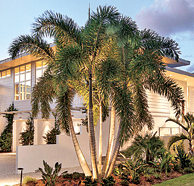The foxtail palm (Wodyetia bifurcate) is the epitome of a true specimen palm. The foxtail being the only species in its genus Wodyeti, this palm claims a name for itself by its unique nomenclature and origin story. Originally found in the Australian outback, the tree gained its botanical name from an aboriginal man who stumbled across the palm in a national park. The Wodyeti man brought back his findings to local botanists to inquire what the palm species may be. With its bright bushy green leaves in the form of a “foxtail” the botanists were floored by its beauty and unique characteristics. With locals catching wind of this new distinct palm, it started to be distributed across the world making it one of the most adaptable and disease resistant palms in the world.
Foxtail palms are great accents in the landscape. They can be grown as single, double or all the way up to eight plus stem palms, making for a beautiful specimen in the landscape. Single stem foxtails can be used for lining driveways or the entrance to your home, double foxtails can be used to frame views in between the trunks and triples are a spectacle within themselves to serve as a center piece for an island or specific area in your landscape.
Foxtail palms are heavy feeders and require regular applications in four month intervals of a granular palm fertilizer containing micronutrients to keep them looking healthy with dark green fronds. When planting, add good top soil or some organic compost to the hole. They might also require supplemental applications of manganese or magnesium every so often to keep the fronds their prettiest deep-green color. A good indication they might need extra food or nutrients is if the fronds appear yellow or light green. These palms are also self-cleaning adding to their easy care. The old fronds will fall off on their own.
When placing foxtails near your home make sure they have enough space to grow and mature. When foxtails are healthy they will reach up to heights of 30′ in height and 15′ wide with beautiful horizontal scars marking the palm where the old fronds used to be. With a color resemblance similar to the native royal palm and Christmas palm this palm will be sure to stand out with its bushy fronds and brilliant red fruit forming in clusters as you walk beneath the palm fronds and through the landscape.
This column is a joint effort by all at In The Garden, Sanibel’s local garden center located at 3889 Sanibel Captiva Road, Sanibel Island, Florida.
